Effect of childhood asthma and inhaled steroid on adult height: 1.2 cm lower height with budesonide vs. placebo
 The use of inhaled glucocorticoids (ICS) for persistent asthma causes a temporary reduction in growth velocity in prepubertal children. The resulting decrease in attained height 1 to 4 years after the initiation of inhaled glucocorticoids is thought not to decrease attained adult height.
The use of inhaled glucocorticoids (ICS) for persistent asthma causes a temporary reduction in growth velocity in prepubertal children. The resulting decrease in attained height 1 to 4 years after the initiation of inhaled glucocorticoids is thought not to decrease attained adult height. This study published in the NEJM measured adult height in 943 participants in the Childhood Asthma Management Program (CAMP) at age 25. Starting at the age of 5 to 13 years, the participants had been randomly assigned to receive 400 μg of budesonide, 16 mg of nedocromil (not available in the U.S. since 2010), or placebo daily for 4 to 6 years.
Mean adult height was 1.2 cm lower in the budesonide group than in the placebo group (P=0.001) and was 0.2 cm lower in the nedocromil group than in the placebo group. A larger daily dose of inhaled glucocorticoid in the first 2 years was associated with a lower adult height (−0.1 cm for each microgram per kilogram of body weight) (P=0.007). The difference between ICS and placebo was noted only during the first two years of therapy and it was not progressive.
The initial decrease in attained height associated with the use of inhaled glucocorticoids in prepubertal children persisted as a reduction in adult height, although the decrease was not progressive or cumulative.
Editor's note: This study shows that more severe asthma that requires treatment with ICS is associated with lower height as an adult. Many chronic diseases during childhood affect adult height and asthma is no exception. A longer time since asthma diagnosis and atopy (any positive skin test) were independent risk factors for shorter adult height. When asthma and atopy impair growth, the deficit may persist into adulthood. The conclusion is not to "stop" the use of ICS but to use the lowest effective ICS dose for symptom control, which is in agreement with the current asthma guidelines.
By the way, the findings of the 2012 study in the NEJM contradict a 2000 study published in the same journal that did not show an effect of ICS on growth (Effect of Long-Term Treatment with Inhaled Budesonide on Adult Height in Children with Asthma - NEJM http://goo.gl/qM3Nf).
Asthma Inhalers (click to enlarge the image).
Comments by other physicians:
This article is an attempts to address sensational headlines (http://bit.ly/RLkhSv) such as: "Everybody Panic: Asthma Inhalers May Stunt Growth Permanently", "Asthma Drug Stunts Kids' Height for Life", "Asthma drug may stunt growth permanently", "Study: Asthma medications make you short", etc.
The benefits of ICS in asthma far outweigh a slight decrease in height. However, when compared with placebo and nedocromil, the effect of budesonide is demonstrated as a cause of reduced stature, since all patients were also asthmatic and atopic.
In the paper all the patientes were mild-to-moderate asthma, although the authors didn't take into account the difference of severity of asthma between groups, patients were randomly assigned to the three treatment groups and the differences between the groups were significant.
Andrew S Nickels, MD:
Looking at the original Childhood Asthma Management Program (CAMP) cohort, the baseline characteristics that are reported seem matched, which would suggest adequate randomization. (1) One lacking aspect of initial enrollment demographics in the original trial cohort is the initial tanner staging being reported. This is pointed out by Mary Ellen Wohl and Joseph A Majzoub in their editorial response to the initial trial.(2) This seems a crucial baseline statistic when assessing growth velocity and final height.
However, while the cohorts may have been similar at baseline, there were significant differences between the inhaled Budesonide and Placebo groups in regards to several outcomes. These include the following: course of oral Prednisone (70/100 person-years vs 122/100 person-years, P below 0.0001), Urgent care visits due to asthma (12/100 person-years vs 22/100 person-years, P below 0.0001), and Hospitalizations due to asthma (2.5/100 person-years vs 4.4100 person-years, p = 0.04). (1) Intuitively, one would expect the higher burden of asthma morbidity felt by the placebo group would negatively effect height,
but that conclusion is outside of the scope of these investigations. As pointed out by Wohl and Majzoub, growth is a complex and poorly understood process. (2) This study outlines a loose association at best between two groups whose developmental years are dissimilar. A larger cohort would be needed with tighter subgroup analysis to tease out this finding. This will be limited by the unethical nature of enrolling known asthmatic children in placebo control trials. (3)
1. The Childhood Asthma Management Program Research Group. Long Term Effects of Budesonide or Nedocromil in Children with Asthma. N Engl J Med 2000; 343:1054-1063.
2. Wohl M, Majzoub J. Asthma, Steroids, and Growth. N Engl J Med 2000; 343:1113-1114.
3. Coffey MJ, Wilfond B, Ross LF. Ethical assessment of clinical asthma trials including children subjects. Pediatrics. 2004; 113: 87-94
References:
Effect of Inhaled Glucocorticoids in Childhood on Adult Height. H. William Kelly, Pharm.D., Alice L. Sternberg, Sc.M., Rachel Lescher, M.D., Anne L. Fuhlbrigge, M.D., Paul Williams, M.D., Robert S. Zeiger, M.D., Ph.D., Hengameh H. Raissy, Pharm.D., Mark L. Van Natta, M.H.S., James Tonascia, Ph.D., and Robert C. Strunk, M.D. for the CAMP Research Group, September 3, 2012 (10.1056/NEJMoa1203229) (free full text).
Inhaling steroids stunts growth, but not much. "This is mostly good news. Now we know what it is. It is a half an inch" | Reuters http://goo.gl/zkTpc
Children treated daily with ICS grow 0.5 cm less during the first year of treatment, no difference second year http://buff.ly/1jSwb1f
Image source: Image source: FDA and Wikipedia, public domain.